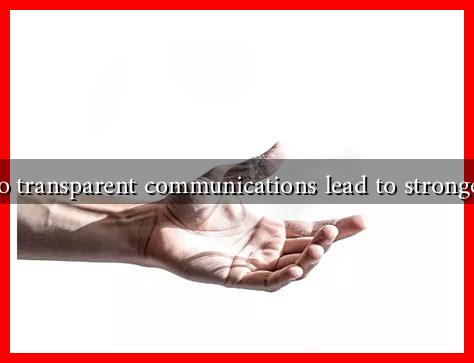-
Table of Contents
Why Do Transparent Communications Lead to Stronger Trust?
In an age where information is abundant and skepticism is rampant, transparent communication has emerged as a cornerstone of trust-building in both personal and professional relationships. Whether in business, politics, or interpersonal interactions, the clarity and honesty of communication can significantly influence how trust is established and maintained. This article explores the reasons why transparent communications foster stronger trust, supported by examples, case studies, and relevant statistics.
The Essence of Transparency
Transparency in communication refers to the practice of being open, honest, and straightforward in sharing information. It involves not only conveying messages clearly but also being willing to share the rationale behind decisions and actions. Here are some key elements of transparent communication:
- Clarity: Ensuring that messages are easily understood.
- Honesty: Providing truthful information, even when it may be uncomfortable.
- Accessibility: Making information readily available to all stakeholders.
- Responsiveness: Engaging with feedback and questions openly.
Building Trust Through Transparency
Trust is a fundamental component of any relationship, and transparent communication plays a pivotal role in its development. Here are several reasons why transparency leads to stronger trust:
1. Reduces Uncertainty
When individuals or organizations communicate transparently, they reduce ambiguity and uncertainty. This clarity helps stakeholders feel more secure in their understanding of situations. For instance, during the COVID-19 pandemic, organizations that provided regular updates about health protocols and safety measures were more likely to gain the trust of their employees and customers. According to a survey by Edelman, 65% of respondents said they trust a company more when it communicates openly about its challenges.
2. Fosters Accountability
Transparent communication encourages accountability. When leaders share their decision-making processes and the factors influencing their choices, they are more likely to be held accountable for their actions. This accountability builds trust, as stakeholders feel assured that leaders are acting in their best interests. A notable example is the tech company Buffer, which openly shares its revenue, salaries, and even mistakes with its employees and the public, fostering a culture of trust and accountability.
3. Enhances Engagement
Transparent communication invites engagement from stakeholders. When people feel informed and included in discussions, they are more likely to participate actively. This engagement can lead to a stronger sense of community and loyalty. For example, companies like Zappos have built their brand on transparent communication, encouraging employees to share ideas and feedback openly, which has resulted in high employee satisfaction and customer loyalty.
4. Builds Reputation
Organizations that prioritize transparency often enjoy a better reputation. A study by the Harvard Business Review found that companies with high transparency levels are perceived as more trustworthy, leading to increased customer loyalty and employee retention. In contrast, organizations that withhold information or engage in deceptive practices can quickly lose trust and face reputational damage.
Case Studies in Transparent Communication
Several organizations exemplify the power of transparent communication:
- Patagonia: The outdoor clothing brand is known for its commitment to environmental sustainability and transparency about its supply chain practices. This openness has garnered a loyal customer base that trusts the brand’s values.
- Whole Foods: The grocery chain has built trust with consumers by being transparent about its sourcing practices and ingredient lists, allowing customers to make informed choices.
- Starbucks: The coffee giant regularly shares its business practices and sustainability efforts with customers, reinforcing its commitment to ethical sourcing and community engagement.
Conclusion
Transparent communication is not just a best practice; it is a vital strategy for building and maintaining trust in any relationship. By reducing uncertainty, fostering accountability, enhancing engagement, and building a positive reputation, organizations and individuals can create a foundation of trust that leads to long-term success. As we navigate an increasingly complex world, embracing transparency in our communications will be essential for fostering trust and collaboration.
For further reading on the importance of transparency in communication, you can explore resources from the Edelman Trust Barometer.

